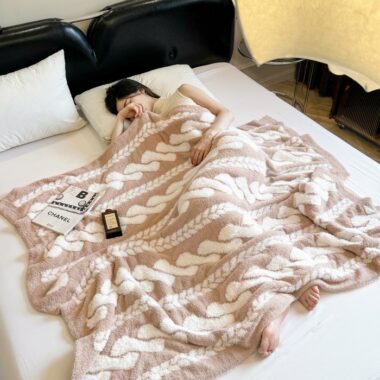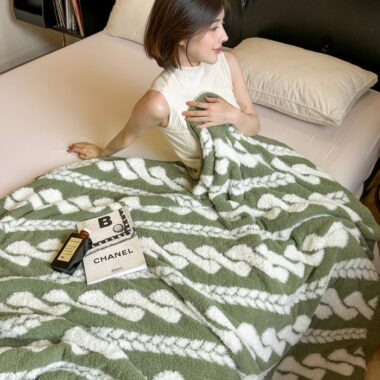Blankets may seem simple at first glance, but for buyers sourcing in bulk, the choice of material is critical. Each fabric offers a unique balance of softness, warmth, durability, and price. Selecting the right material not only affects customer satisfaction but also defines brand positioning in the market. This guide compares the most common blanket materials—fleece, wool, mink, polyester, and cotton—helping wholesale buyers and retailers make informed decisions.
➤ Fleece Blankets: Lightweight and Versatile
Fleece is one of the most popular blanket materials due to its soft feel and affordable cost. Made from polyester fibers, fleece is lightweight, quick-drying, and easy to care for. It is especially popular for casual home use, promotional events, and retail projects where cost efficiency matters. Wholesale fleece blankets are often available in multiple colors and GSM weights, giving buyers flexibility for different markets. A blanket supplier can also provide custom printing, embroidery, or edging to create unique retail-ready products.
➤ Wool Blankets: Natural Warmth and Premium Appeal
Wool has been a traditional choice for centuries, valued for its insulation and breathability. Wool blankets are warm in winter yet allow air circulation, making them comfortable across seasons. They are considered premium products, often used by hotels, outdoor brands, or luxury retailers. However, wool requires more care, as it can shrink if washed improperly. Buyers seeking high-end positioning should consider working with a blanket factory experienced in wool processing, ensuring consistent quality and durability.
➤ Mink Blankets: Plush and Decorative
Mink blankets, also known as faux mink or raschel blankets, are thick, plush, and highly decorative. They are not made from real animal fur but from synthetic fibers like acrylic or polyester. With vibrant patterns and bold colors, they are especially popular in regions such as the Middle East, Africa, and Latin America. These blankets often serve as statement pieces in homes or gifts for special occasions. For bulk buyers, mink blankets provide strong retail appeal and higher margins compared to simpler designs.
➤ Cotton Blankets: Soft and Breathable
Cotton remains one of the most trusted natural fibers in textiles. Cotton blankets are breathable, hypoallergenic, and suitable for year-round use. They are widely accepted in both Western and Asian markets, making them a safe choice for wholesale buyers. Cotton blankets also offer opportunities for customization, including woven patterns, dyed colors, or eco-friendly packaging. Buyers working with a blanket supplier can request organic cotton or blends to appeal to environmentally conscious customers.
➤ Polyester and Synthetic Blends: Cost-Effective Options
Polyester and acrylic blends are often used to produce blankets that are durable, lightweight, and low-cost. These materials are suitable for promotional products, giveaways, and large-scale wholesale projects where budget is a priority. Although they may not have the same premium feel as wool or cotton, they are versatile and easy to care for. Factories specializing in synthetic blankets can deliver consistent bulk supply with fast lead times, making them attractive for buyers with tight schedules or limited budgets.
◆ Comparing Price and Market Position
Each material aligns with a different market segment.
— Fleece: Budget-friendly, everyday use.
— Wool: Premium, long-lasting, luxury appeal.
— Mink: Decorative, culturally popular, mid-to-high margin.
— Cotton: Natural, safe, versatile for all buyers.
— Polyester/Acrylic: Affordable, bulk promotional use.
Understanding these distinctions helps buyers choose a material that matches their target customers while balancing costs and margins.
◆ Customization Across Materials
Regardless of the fabric, customization is now a standard expectation. Factories can provide custom blankets with unique sizes, edging styles, embroidery, or branded packaging. For example, fleece and polyester are easier for mass-printed designs, while wool and cotton may be better for woven or embroidered patterns. Buyers should discuss options with their blanket supplier early in the process to avoid production delays.
◆ Quality Control and Buyer Considerations
The choice of material also influences quality testing. Wool requires careful checks for shrinkage and fiber strength, while polyester blankets need consistent dyeing and finishing. Buyers sourcing in bulk should request quality reports and, whenever possible, third-party certifications. Working directly with a blanket manufacturer ensures stricter quality control and reduces risks of defective shipments.
Conclusion
Choosing the right blanket material is not simply about softness or price—it’s about aligning the product with customer expectations, brand positioning, and wholesale market demands. Fleece offers affordability, wool provides natural luxury, mink creates decorative appeal, cotton ensures breathability, and polyester blends balance cost with efficiency. By working closely with an experienced blanket factory or supplier, buyers can access a wide range of custom blankets, ensuring their orders are both competitive and market-ready.








